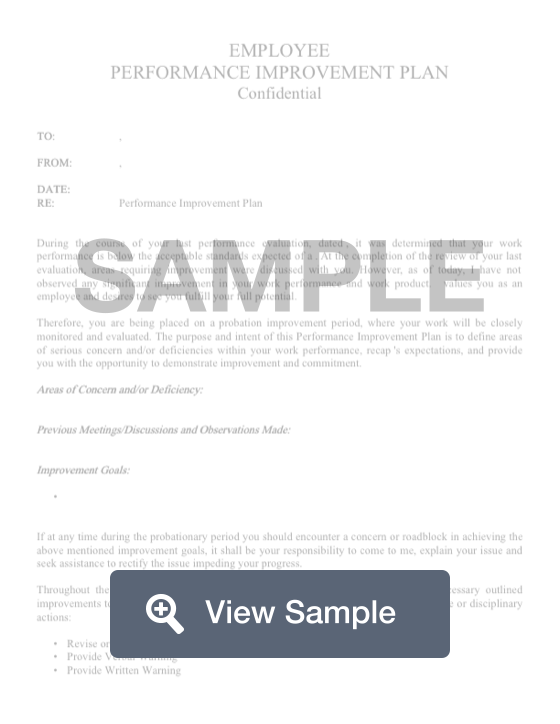What is a performance improvement plan (PIP)?
A Performance Improvement Plan, also known as a PIP, is a formal document that is used by businesses and companies as a way to evaluate an employee's performance and set goals on how this performance can be improved. The form may be used for anyone from a manager to a sales associate.
This form will typically include a number of steps that will be followed in order for the employee to improve their job performance. A time limit may be included. The employee must do their best to meet these steps for performance improvement by that time or consequences may be given.
A PIP may be given to an employee during performance review season after an unsatisfactory performance review. The PIP process will give an employee a chance to learn more and change before disciplinary action is taken. It can also be appropriate for someone who is new to a position and is having trouble figuring out what to do. This form lists goals in a formal fashion, so all parties involved will understand the expectations of the employee.
When is a performance improvement plan needed?
A PIP should be used by organizations that are committed to helping an employee improve. When determining whether a performance plan is appropriate, you should consider:
- Is there an employee performance issue that can be specified? Create a list the details the employee's poor performance, include data or explanations and previous discussions with the employee.
- Is the management system committed to helping the employee succeed or are they committed to terminating the employee? If the manager does not want to help, the PIP will not be effective.
- Does the employee have the proper training to succeed at the task? Additional training may be part of the solution.
- Can issue can be solved through a formal improvement plan? The goal-oriented process of a PIP is often useful for helping with problems with sales goals, quality ratings, quantity objectives and similar issues.
How to establish a performance improvement plan
The employee’s manager should create a draft improvement plan for human resources to review. The PIP should include:
- Detailed information on what acceptable performance levels are for the employee's current role and how the employee's performance is deficient. Include specifics regarding the unacceptable performance, including dates, performance metrics, and detailed explanations. Attach the job description and any relevant employer policies to further clarify expectations.
- Specific measurable objectives that are achievable, relevant, and time-bound (SMART goals). PIPs last for a specific period of time that allow the employee to achieve those goals.
- Information about what management will do to support the employee in achieving these goals. Include details about additional training, mentoring, or resources available to the employee.
- Outline timeline for manager and employee to meet and discuss progress.
- State consequences for failure to meet objectives: demotion, transfer, or termination.
HR should review the manager’s plan for fairness. Is the employee being given enough time to improve? Does the employee have adequate tools and training to meet the stated goals?
Once HR has signed off on the plan, the manager should meet with the employee to discuss the plan. The manager should encourage the employee to give feedback and ask questions. The manager may decide to modify the plan based on employee feedback. Once HR has reviewed the final plan, both the manager and the employee should sign the plan. The employee’s progress with the PIP should be monitored with regularly scheduled meetings. The manager should document all future conversations with the employee about this issue.
If the employee successfully completed the plan, the manager should formally close the PIP and allow the employee to continue in their role. The manager should ensure that the employee understands that their continued good information is expected.
If the employee does not successfully complete the plain, the PIP should be closed and the employer should consider transfer, demotion, or termination. In some circumstances, the employer may choose to extend the deadline for the PIP, offering the employee another opportunity to improve their performance.
How can I successfully stick to my PIP?
If you have been placed on a PIP, you should make sure that you understand everything that is expected of you. If you have any questions about company expectations, speak to your manager and/or HR.
Throughout the duration of your PIP, you should check in with your manager often about your progress. Knowing where you stand will give you the opportunity to correct any deficiencies before it is too late.
If you are still struggling, consider reaching out to your high-performing peers for advice. They may be able to offer you tips for staying on task and achieving your goals.
Legal Considerations
Some companies do use PIPs to document a firing in advance. This might be the case if the goals that were set for you seem impossible to achieve.
If you feel that your firing is imminent, this may be the right time to get a head start on updating your resume. You should also polish your LinkedIn profile and begin to network with your contacts about other new opportunities. As you are looking for new roles, you should evaluate why you are not able to complete your PIP. Is it because of something in your current company or is it something about working in your field? Answering these questions for yourself will help you to select a role that is a better fit for you as you start a new exciting chapter in life.

